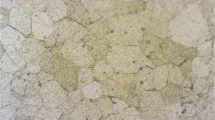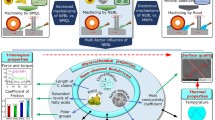Abstract
Minimum Quantity Lubrication (MQL)-based machining process has many merits over not only conventional flood cooling machining but also dry machining. These merits include cost reduction, industrial hygiene, reduction of air-bourn particles etc.. However, few disadvantages make the MQL-based machining process impractical to be adopted in many industrial production settings. More specifically, the cutting speed in a typical MQL process is restricted because the MQL process does not allow efficient cooling of cutting tools. The amount of oil used in MQL processes is barely enough for less aggressive machining conditions and does not effectively cool the cutting tool essential in more aggressive cutting conditions. At high cutting speeds, the oil will simply evaporate or disintegrate as soon as the oil droplets strike the tools already heated to high cutting temperatures. In this paper, new nano-platelet-enhanced MQL oils are developed to mitigate this major deficiency of MQL process. In particular, exfoliated Graphite nano-platelet (xGnP) and XGS Hexagonal Boron Nitride (hBN) produced by XG Science, Inc. (Lansing, Michigan) were mixed into a typical vegetable oil used in MQL process. The process enhancement by these nano-platelets is possible because these nano-platelets in a multiple-layer scheme can readily slide to provide additional lubricity. When the mixture of oil and nano-platelets are applied, the nanoplatelets provide additional lubricity even after the oil droplets have been disintegrated during high speed machining. Thus, the enhancement achieved by adding nano-platelets allows us to expand the processing envelope of MQL. In this paper, not only the comparison between xGnP and XGS hBN but also multiple combinations of nano-platelet-enhanced MQL oils with varying contents have been studied with a ball-on-disc set-up in a reciprocating motion in order to study the friction and wear characteristics of these lubricants. More importantly, MQL-based ball-milling experiment has been conducted with these mixtures, which show very promising results for future MQL research.
Similar content being viewed by others
Abbreviations
- θ:
-
Diffraction angle
- s:
-
surface area per a gram
- v:
-
specific volume
- DOC:
-
depth of cutting
References
Klocke, F. and Eisenblatter, G., “Dry Cutting,” CIRP Annals-Manufacturing Technology, Vol. 46, No. 2, pp. 510–526, 2097.
Shen, B., Malshe, A. P., Kalita, P., and Shih, A. J., “Performance of Novel MoS2 Nanoparticles Based Grinding Fluids in Minimum Quantity Lubrication Grinding,” Transaction of NAMRI/SME, Vol. 36, pp. 357–364, 2008.
Kwon, P. and Drazl, L., “Nanoparticle Graphite Based Minimum Quantity Lubrication Method and Composition,” Michigan State University, Serial No. 12/655,649, 2008.
Park, K.-H., Ewald, S., and Kwon, P., “Effect of Nano-Enhanced Lubricant in Minimum Quantity Lubrication (MQL) Balling Milling,” J. Tribology, Vol. 39, No. 12, pp. 517–521, 2011.
Weinert, K., Inasaki, I., Sutherland, J. W., and Wakabayashi, T., “Dry Machining and Minimum Quantity Lubrication,” Annals CIRP, Vol. 53, No. 2, pp. 511–537, 2004.
Reddy, N. S. K. and Rao, P. V., “Experimental investigation to study the effect of solid lubricants on cutting forces and surface quality in end milling,” Int. J. Machine Tool and Manuf., Vol. 46, pp. 189–198, 2006.
Yoshimura, H., Itoigawa, F., Nakamura, T., and Niwa, K., “Development of Nozzle System for Oil-on-water Droplet Metalworking Fluid and its Application to Practical Production Line,” JSME Int. J., Vol. 48, No. 4, pp. 723–729, 2005.
Donnet, C. and Erdemir, A., “Solid lubricant coatings: recent developments and future trends,” Tribology Letters, Vol. 17, No. 3, pp. 389–397, 2004.
Yukhno, T. P., Vvedensky, Y. V., and Sentyurikhina, L. N., “Low temperature investigations on frictional behaviour and wear resistance of solid lubricant coatings,” Tribology International, Vol. 34, pp. 293–298, 2001.
Prasad, B. K., Rathod, S., Yadav, M. S., and Modi, O. P., “Effects of Some Solid Lubricants Suspended in Oil Toward Controlling the Wear Performance of a Cast Iron,” J. Tribology, Vol. 132, No. 4, pp. 041602-1–041602-9, 2010.
Prasad, B. K., “Effectiveness of an Externally Added Solid Lubricant onthe Sliding Wear Response of a Zinc-Aluminium Alloy, its Composite and Cast Iron,” Tribol. Lett., Vol. 18, pp. 135–143, 2005.
Lee, C.-G., Hwang, Y.-J., Choi, Y.-M., Lee, J.-K., Choi, C., and Oh, J.-M., “A Study on the Tribological Characteristics of Graphite Nano Lubricants,” Int. J. Precis. Eng. Manuf., Vol. 10, No. 1, pp. 85–90, 2009.
Hsu, M. S., “Nano-lubrication: concept and design,” Tribology International, Vol. 37, pp. 537–545, 2004.
Rao, D. N. and Krishna, P. V., “The influence of solid lubricant particle size on machining parameters in turning,” Int. J. Machine Tool and Manuf., Vol. 48, pp. 107–111, 2008.
Huang, H. D., Tu, J. P., Gan, L. P., and Li, C. Z., “An investigation on tribological properties of graphite nanosheets as oil additive,” Wear, Vol. 261, pp. 140–144, 2006.
Bartz, W. J., “Solid lubricant additives — effect of concentration and other additives on anti-wear performance,” Wear, Vol. 17, No. 5–6, pp. 421–432, 2071.
Haubner, R., Wilhelm, M., Weissenbacher, R., and Lux, B., “Boron Nitrides — Properties, Synthesis and Applications,” High Performance Non-Oxide Ceramics II, Structure & Bonding, Vol. 102, pp. 1–45, 2002.
Zhu, Q., Qiu, X., and Ma, C., “The oxidation resistance improvement of matrix graphite of spherical fuel elements by slip-gelation process,” Journal of Nuclear Materials, Vol. 254, pp. 221–225, 2098.
Watanabe, S., Miyake, S., and Murakawa, M., “Tribological properties of cubic, amorphous and hexagonal boron nitride films,” Surface and Coatings Technology, Vol. 49, pp. 406–410, 2091.
Kimura, Y., Wakabayashi, T., Okada, K., Wada, T., and Nishikawa, H., “Boron nitride as a lubricant additive,” Wear, Vol. 232, pp. 199–206, 2099.
http://www.henze-bnp.de/html/eng/boron_nitride/what/what_is_boron_nitride.php (from Encyclopedia Britannica, Inc., 2095.)
Fukushima, H., “Graphite nano-reinforcements in polymer nanocomposites,” Ph.D. Thesis, Department of Chemical Engineering and Materials Science, Michigan State University, 2003.
Khare, V., Ruby, C., Sonkaris, S., and Taubert, A., “A Green and Sustainable Nanotechnology: Role of Ionic Liquids,” Int. J. Precis. Eng. Manuf., Vol. 13, No. 7, pp. 1207–1213, 2012.
Park, K.-H., Olortegui-Yume, J., Yoon, M.-C., and Kwon, P., “A Study on Droplets and their Distribution for Minimum Quantity Lubrication (MQL),” International Journal of Machine Tools & Manufacture, Vol. 50, No. 9, pp. 824–833, 2010.
Author information
Authors and Affiliations
Corresponding author
Rights and permissions
About this article
Cite this article
Nguyen, T.K., Do, I. & Kwon, P. A tribological study of vegetable oil enhanced by nano-platelets and implication in MQL machining. Int. J. Precis. Eng. Manuf. 13, 1077–1083 (2012). https://doi.org/10.1007/s12541-012-0141-0
Received:
Accepted:
Published:
Issue Date:
DOI: https://doi.org/10.1007/s12541-012-0141-0




